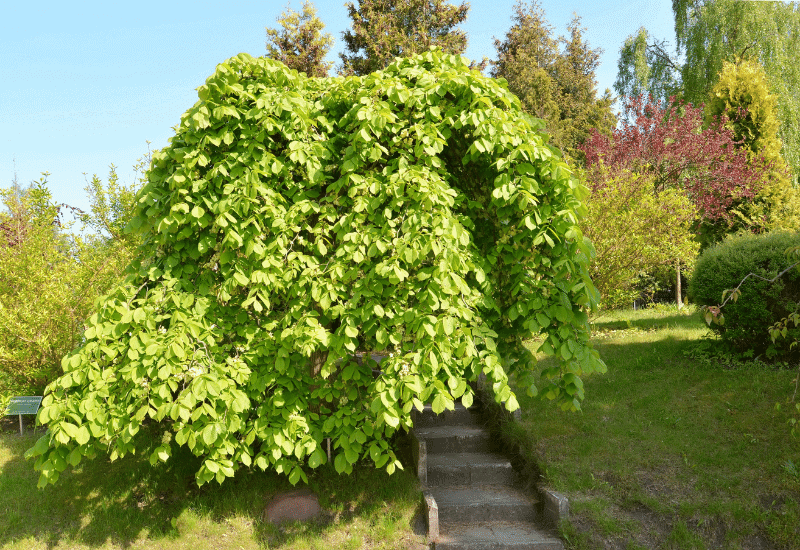
Elms are a group of deciduous trees in the Ulmus genus. The majority of these species are large shade trees with a spreading form. There are many varieties of elm trees. While the quantity of individual varieties remains unknown, estimates indicate that the total is nearly 40.
Less than ten of these elm trees are native to North America. Most of the remaining varieties come from regions throughout the Asian continent. It is relatively easy to discern elms from other kinds of trees.
For North American varieties, the form is almost always large and vase-like. Asian elm varieties have more variation in their form. Sometimes they are upright trees; in other cases, they may take a shrub-like form.
A few reliable ways to distinguish an elm from other large deciduous trees. Elms have leaves that are unlike the leaves of almost any other kind of three. Elm fruits and bark patterns are also unique identification features. The prominent vase-like form once made elms one of the most popular trees in the United States.
Unfortunately, the Dutch elm disease has drastically reduced the population of elms. In this article, we will teach you how to identify the different types of elm trees. Many of these species share many similarities, so it takes a trained eye to differentiate between them.
Elm tree identification is easiest when you focus on three key features.
Read on to learn how you can use those three features to tell elms apart from other tree species.
Elm Leaves
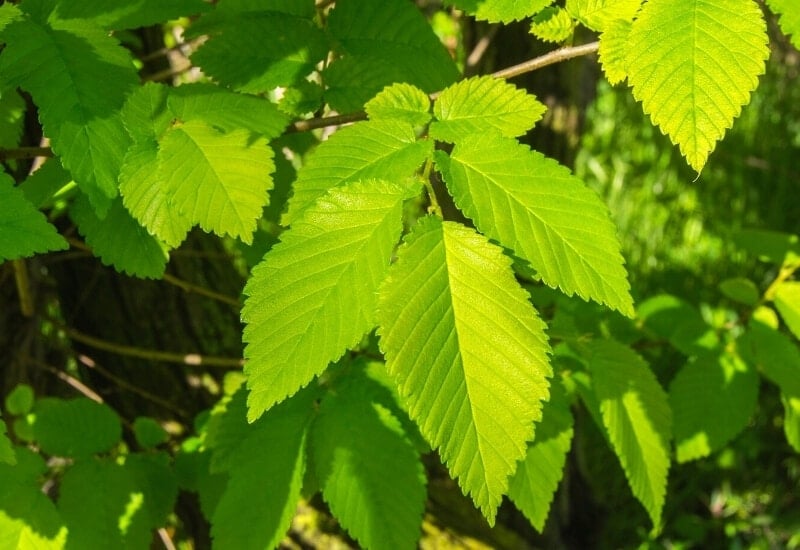
Most species of elm have simple deciduous leaves. Each leaf has an oblong shape and a serrated margin that tapers to a sharp point at the apex.
One of the most noticeable features of elm leaves occurs at the opposite end of the leave. The base of each elm leaf is distinctly asymmetrical, and this uneven appearance results from one side of the leaf growing further down the petiole than the other.
For the majority of the year, the leaves have a medium green color. Through rather unremarkable, these leaves change color before falling autumn. This color is usually a shade of yellow or brown.
In general, elm leaves are of moderate size, varying from as small as three inches in length to over half a foot.
Elm Bark
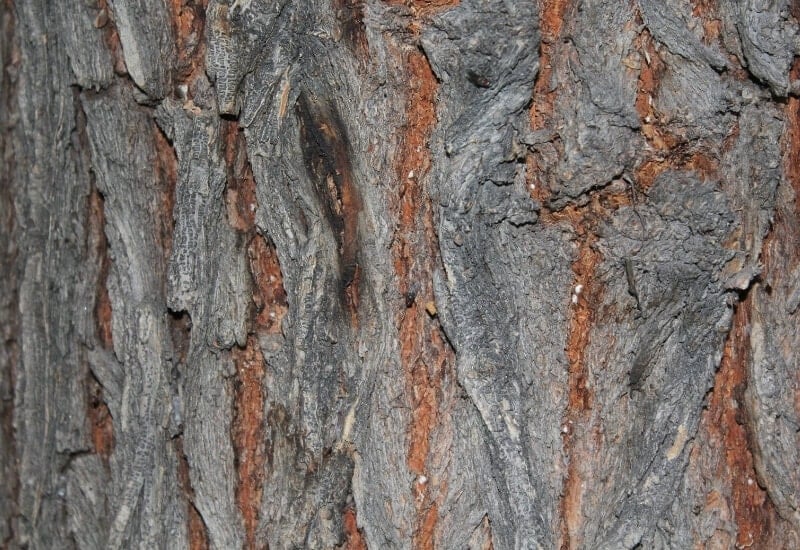
The bark of most elm trees has a series of crossing grooves. Between these groves are thick ridges that can often have a scaly texture.
There is some variety in bark texture between different elm species. But in most cases, elms share the same dark gray color on their trunks and branches.
Elm Fruit
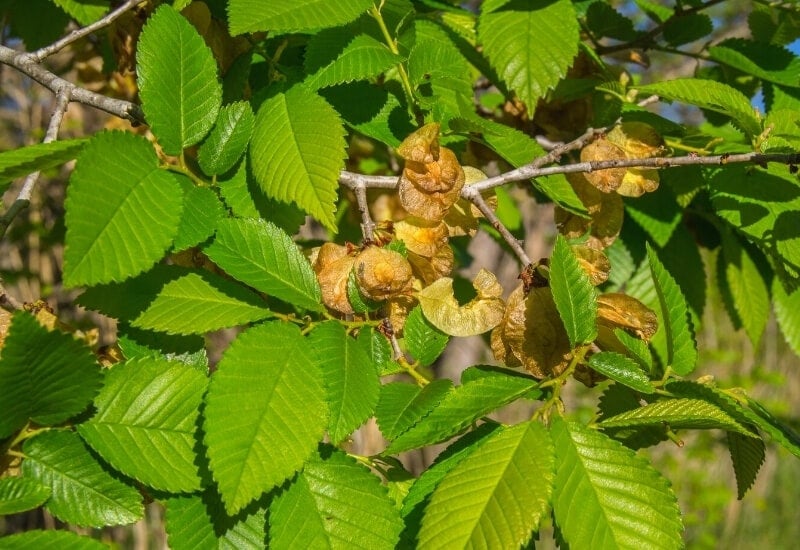
The most accurate way to describe the fruit of an elm tree is to liken it to a small wafter. That is because they are round but thin with a lightly textured outer surface.
The technical name for the fruit of an elm tree is a samara. These samaras can have an oval shape. On some species, they are almost perfectly round.
The seed of the elm tree lives within the samara. Each samara carries a solitary seed in its center. Each samara is usually light green. They appear in high quantities, often in the spring.
How to Identify an Elm Tree?
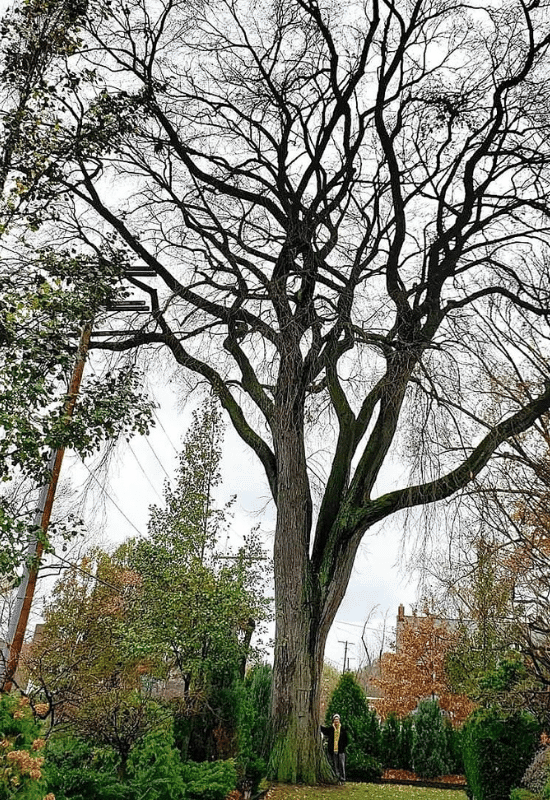
From afar, you can identify an elm tree by its form. Mature specimens will be large with a broad vase shape.
With a closer inspection, you can evaluate the three identification features mentioned above. The leaves will be serrated and oval-shaped. They will also have an uneven base. Look out for the think rounded samaras and the dark furrows in the bark as well.
Recognizing these general features will help you to distinguish an elm from a tree in another genus. Subtle differences in those three identification features will allow you to identify different species within the elm group. The list below will provide descriptions to help you do that.
15 Elm Tree Varieties And How To Identify Them
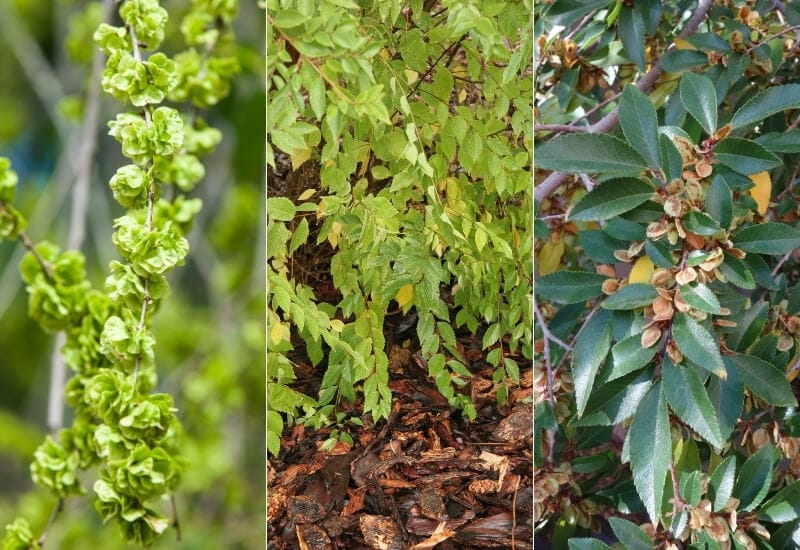
One of the best ways to identify elms is to become familiar with a few different varieties. That way you can see the subtle differences in leaves, bark, and fruits that help in identification. Below is a list of wild and cultivated varieties of elm trees to help you get started.
1: Ulmus Americana (American Elm)
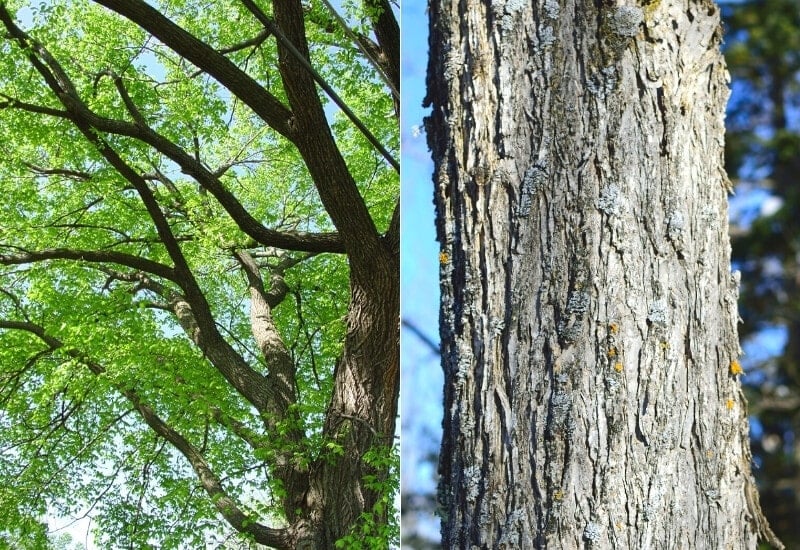
Before the introduction of Dutch elm disease, American elm was perhaps the most popular street tree in the United States. Since the arrival of the disease, this species has been nearly wiped out.
American elm is a deciduous tree with an attractive spreading vase form. At maturity, this tree reaches 80 feet in height and has a spread that nearly matches. This provides plenty of shade in hotter months.
Sadly, this tree is no longer a viable option. The odds of this tree dying at the hands of Dutch elm disease are simply too high. Currently, horticulturalists are working to develop new disease-resistant cultivars. So far, they have hasmoderate success.
Leaves
American elm leaves are about six inches long. They have an asymmetrical base and deep serration along the margin. They have an oval shape that tapers to a point. They are dark green may turn yellow in fall.
Bark
The bark is dark grey. It has long continuous vertical ridges. These can be thin or broad and meander through deep fissures. At times they can have a scaly texture.
Fruit
The fruit of American elm is a samara shaped like a disc. They have tiny hairs and a light green color. There are red accents as well as small hairs. These samaras mature in late spring.
2: Ulmusglabra (Scotch Elm)
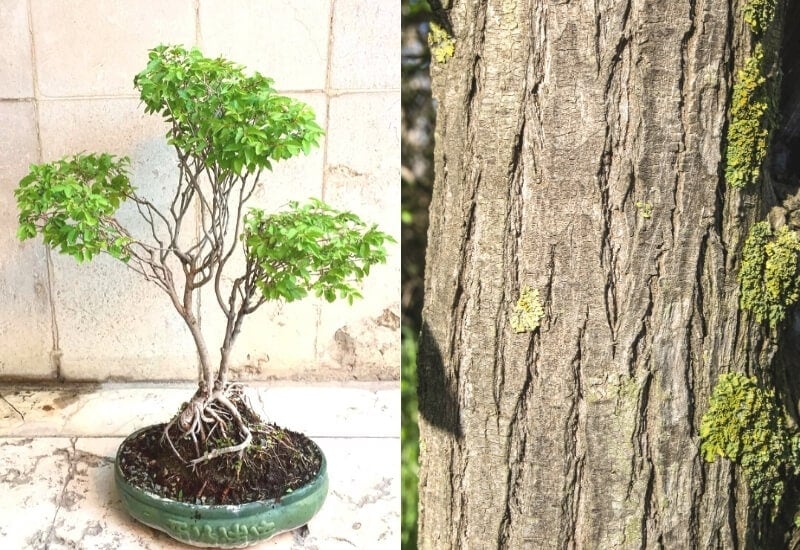
Scotch elm is even larger than American elm. It reaches 100 feet and has a more open habit.
This tree prefers alkaline soils and adapts to harsh conditions including urban environments. It is also able to survive in both wet and dry areas. Its one downfall is, again, the Dutch elm disease.
Leaves
The leaves of Scotch elm vary in length from three to seven inches. Their width is between one and four inches. The margins are somewhat wavy and have deep serrations. The base is asymmetrical and the apex sometimes has three lobes. However, an oval shape is more common.
Bark
Newer bark on Scotch elm is much more smooth than on other elm varieties. As it ages, this bark begins to crack into long flakes with shallow faults in between.
Fruit
Scotch elm has tan samaras that appear in abundance in spring. They look like a very textured and irregular sphere. Each sphere holds one seed.
3: Ulmusparvifolia(Chinese Elm)
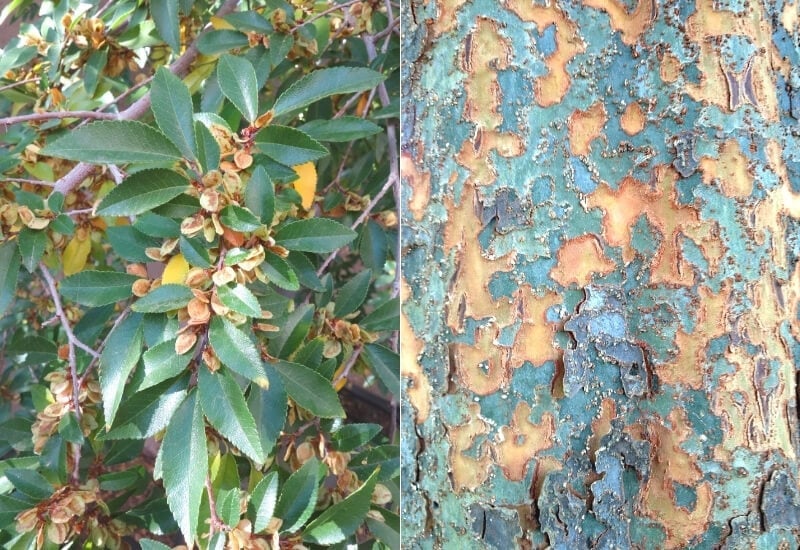
Unlike the previous two elms on our list, Chinese elm is a medium-sized tree. Still, it has a fairly substantial size and a rounded form. Its lower branches have a pendulous habit.
As you would expect, this tree is native to East Asia. As you might not expect, it has a resistance to Dutch elm disease.
Unfortunately, there is another aspect of this plant that outweighs that resistance. This tree is considered invasive in the United States. So even though it will survive much better than other elms, planting Chinese elm is not prudent.
Leaves
Chinese elm leaves are a bit smaller at around two inches in length. They have an overall ovate shape with a rounded, slightly uneven base. The undersides are pubescent. The leaves turn light red in the fall.
Bark
The bark of Chinese elm may be its most distinctive characteristic. This bark exfoliates with small darker grey patches. Beneath these patches is a lighter grey bark. Sometimes the trunk will have a solitary flute running its length.
Fruit
Chinese elm samaras mature later in the season in early fall. They are oval-shaped and often have a notch at their apex. They are less than half an inch long.
4: Ulmuspumila (Siberian Elm)
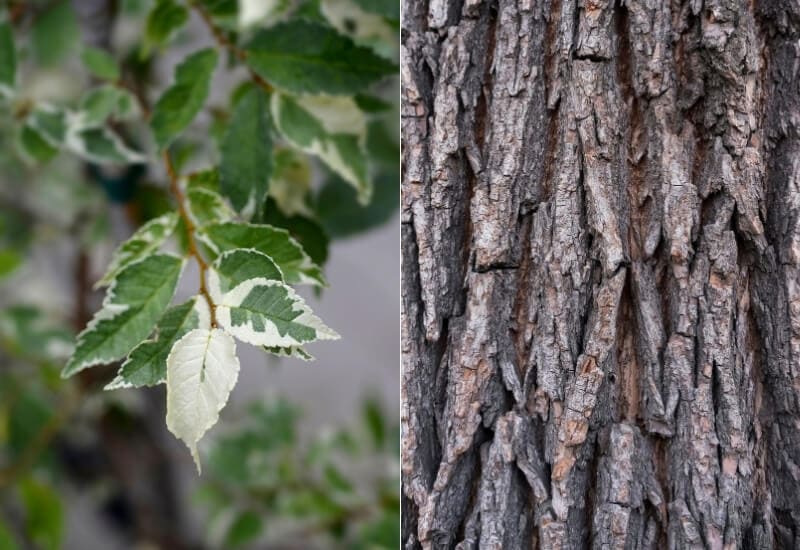
Siberian elm grows in an upright habit. This is a contrast to many other elms that typically have a rounded or vase shape.
This species grows quickly and in almost any setting. This includes poor soils and limited sun exposure.
The fast growth habit leads to a weak wood in this tree. As a result, it can easily break underweight or when facing strong winds. Siberian elm also has a strong ability to spread via self-seeding.
While this tree is somewhat resistant to Dutch elm disease, it has the same problem as Chinese elm. In fact, it may be even more invasive in the United States.
Leaves
Siberian elm leaves are a narrower version of other elm leaves. They also have an uneven base but this unevenness can be hardly noticeable at times. They have a smooth texture and a dark green color. At maturity, these leaves have a firmness that sets them apart from other elm leaves.
Bark
The bark is light gray with wavy ridges. Between the ridges are textured fissures of a medium depth. Younger branches have smoother bark and shallow fissures that show orange.
Fruit
Like other elms, Siberian elm has samaras as its fruits. These are nearly perfect circles with the seed situated in the center. They have a deep notch at the apex and are about half an inch in diameter.
5: Ulmusalata(Wingedelm)
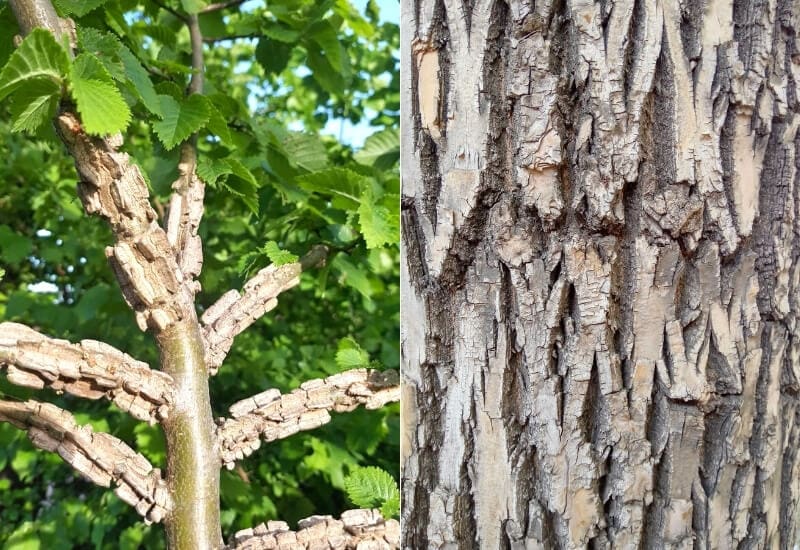
Winged elm is a medium-sized deciduous tree native to the northeastern part of the United States. In its native range, it grows in areas with very different growing conditions. This includes rocky areas at high elevations as well as wetter lowlands.
The habit of this tree is somewhat open. It has a rounded crown and usually reaches 30 to 50 feet at its mature height.
Along with the Dutch elm disease, winged elm can have other problems. Most notably, this plant is susceptible to powdery mildew.
Leaves
The leaves of winged elm have a leathery texture and a double serration at its margin. They are dark green and alternate with an oblong but pointed shape. They are about two inches long.
Bark
Bark on winged elm is almost identical to American elm. The difference is that these shared characteristics are slightly less pronounced on winged elm.
Fruit
Winged elm has oval-shaped samaras as its fruit. These are less than half an inch in total length. At their apex, there are two curved structures.
6: Ulmusrubra (Slippery Elm)
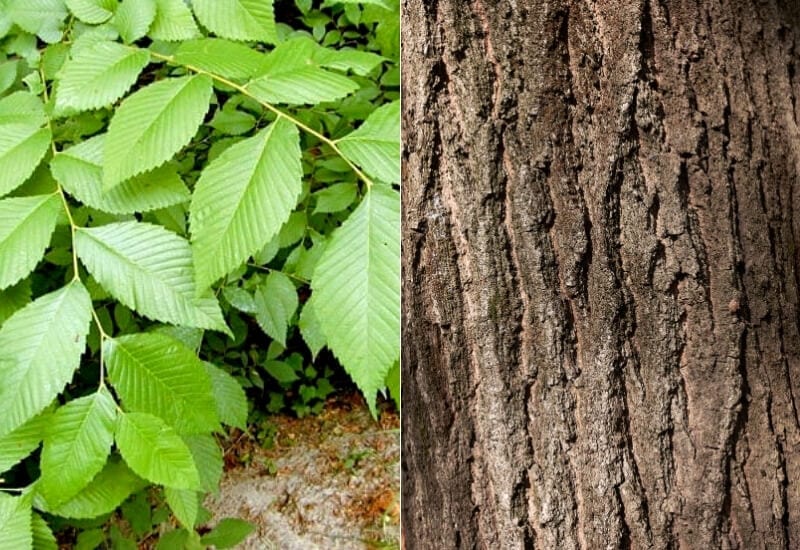
Slippery elm is a large woodland tree native to the United States. Even before the introduction of Dutch elm disease, this tree was rarely planted in either residential or urban settings.
This is mainly due to the fact that this tree has a relatively unattractive form which can look unkempt. It has an overall coarse texture that makes it less preferred compared to its relatives.
Slippery elm proves to be a long-lasting deciduous tree when not afflicted by the disease. It also has many historical uses among indigenous groups.
Leaves
The leaves of slippery elm are half as wide as they are long. Their length varies between four and eight inches. They are noticeably unequal at the base and have a pointed oval shape with regular serration.
Bark
Slippery elm bark is light gray on the outside. On the inside, it has a reddish-brown color. The exterior layers form thin plates of smooth bark. These plates are cracked in many places.
Fruit
The slippery elm samaras grow in numerous clusters. They are circular and flat like a coin. In the center, they have many reddish hairs. Their main color is a light green.
7: Ulmusminor(Smoothleafelm)
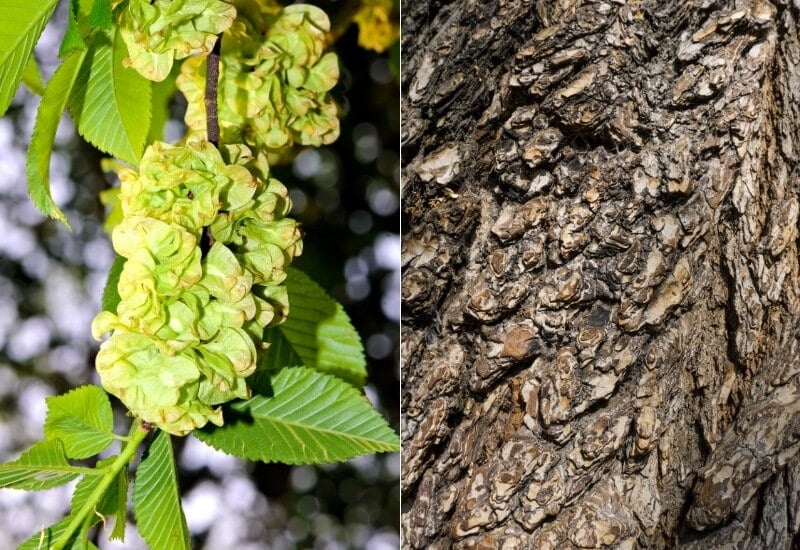
Native to Europe and North Africa, smoothleaf elm is a fast-growing tree with a pyramidal form. This form often reaches a height of around 70 feet. At times this form can be more narrow. The depends on how upright the branches happen to grow.
The main attraction to this plant is its disease resistance. While only moderate, this resistance is significantly better than that of all other non-cultivated non-invasive elms.
Because of this, smoothleaf elm has been a starting point for many elm cultivars. With each new variety, botanists attempt to build on smoothleaf elm’s slightly higher disease resistance.
Leaves
Smoothleaf elm leaves are ovate but with a more elongated form. This emphasizes the uneven base. The margins are serrated and taper to a point at the apex. It has a yellow fall color that is unreliable.
Bark
Bark on the trunk of smoothleaf elm is typically light grey and textured. This texture consists of light flakelike pieces set amidst shallow light brown grooves.
Fruit
The samaras of smoothleaf elm are small and light green they have around but flat form that has a distinct notch at the top.
8: Ulmusdavidiana Var. Japonica (Japanese Elm)
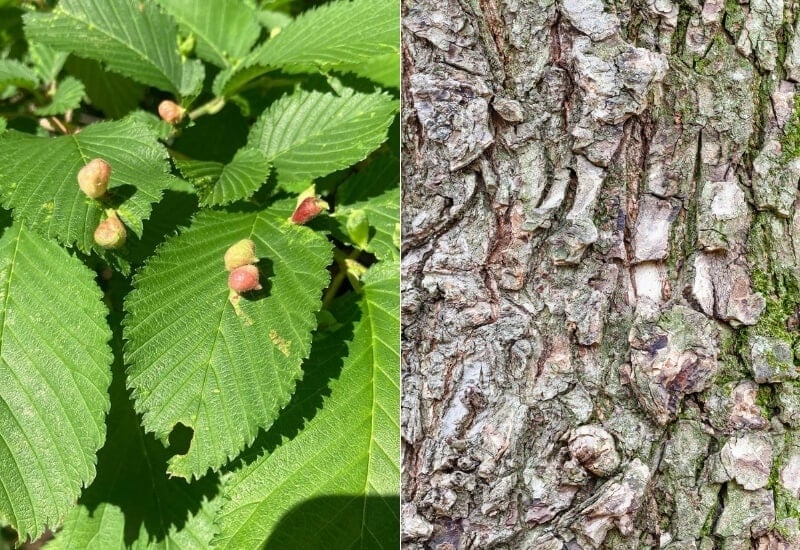
This variety of Japanese elm is the starting point for many of the cultivated elm varieties. This is because this tree has a form very similar to American elm along with strong disease resistance.
This Japanese elm has dense foliage making it a great shade tree. It also has a spreading form that calls for plenty of space for this plant to grow properly.
Japanese elm grows in both cold and warm regions. It adapts to soils of any acidity and has a very fast growth rate of almost three feet per year. However, this fast growth rate leads to a relatively weak structure. So, broken limbs are a safety hazard to watch out for.
Leaves
The leaves of this tree are a muted green. They have a longer but rounded shape and mild serrations. In fall they take on a golden color.
Bark
Most of the young bark on this tree is smooth and light grey with a pattern of lighter markings. This becomes gnarled as the tree matures. Young branches often have wings much like those found on winged euonymus.
Fruit
These samaras are mainly brown and measure less than half an inch. They appear in spring and can have a variable green color as well.
Cultivated Elm Varieties
As mentioned before, there are ongoing efforts to create an elm cultivar with resistance to Dutch elm disease. The following elm varieties are the results of those efforts. So far there is no variety that is both non-invasive and able to completely withstand the disease. But these elms have come the closest to achieving those goals so far.
9: Ulmus ‘Morton’ ACCOLADE (Accoladeelm)
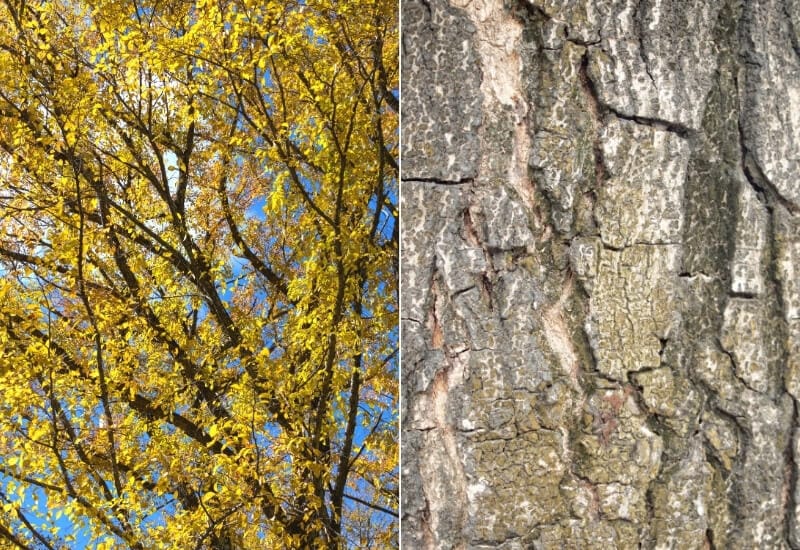
Accolade elm has a lot of positive attributes on its side. For starters, this elm crossbred has some of the most promising resistance to Dutch elm disease.
Though this is not effective in all cases, this resistance represents a significant improvement compared to native elms. In addition, this tree has an aggressive growth habit that increases its survival rate.
Accolade elm is a medium to large tree with a vase form. In recent decades the planting of this tree has increased as it is a potential alternative to native elm species.
Leaves
The leaves grow with a significant density providing plenty of shade. They are dark green and have a glossy texture. In fall they turn yellow. They have a broad oval shape with moderate serration.
Bark
Accolade elm bark can vary in color from brown to gray. In either hue, this bark exfoliates in a series of fissures and ridges.
Fruit
The samaras appear in late spring and are lust below half an inch in length. They tend to have a green color with brown accent hues. They have a thin oval shape.
10: Ulmus × Hollandica ‘Jacqueline Hillier’ (Dutch Elm)
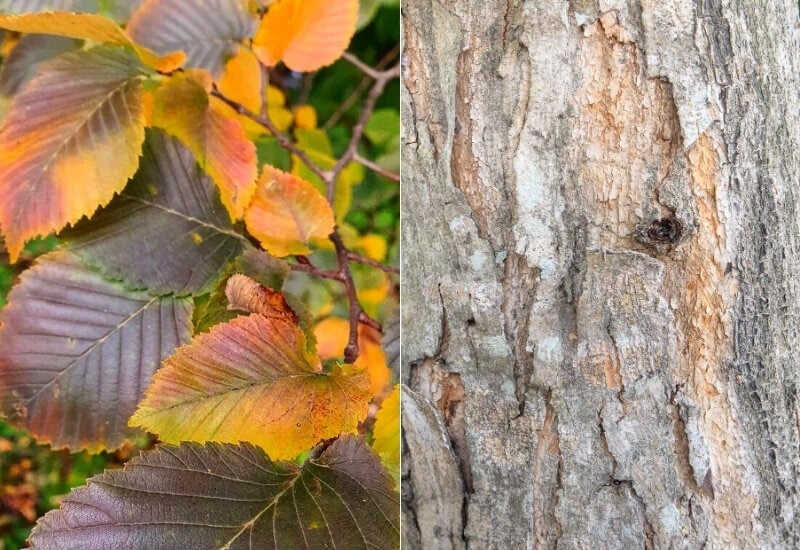
Dutch elm has some of the best resistance to Dutch elm disease. However, this is not because this plant is native to Holland. It is instead, a hybrid cultivar.
While still a small tree, the ‘Jaqueline Hillier’ variety of Dutch elm is significantly smaller than its relatives. At a mature height of 12 feet, it has little more than a tenth of the height of some other elms on this list.
Dutch elm has a dense habit and sometimes is more of a large shrub than a small tree. It also grows quite slowly.
While it is not a great recreation of the large shade-giving elms that are rapidly dying off, Dutch elm’s disease resistance is a hopeful sign.
Leaves
Dutch elm leaves are relatively small with a textured shining surface. They are serrated and about three inches long. In fall they turn yellow.
Bark
The bark of Dutch is light gray and has a mottles texture that provides year-round interest even after the leaves have fallen.
Fruit
The fruit of ‘Jaqueline Hellier’ Dutch elm is just a smaller version of its parent species’ fruit. This is a round light green samara with a reddish center where the seed lies.
11: Ulmusparvifolia ‘Emer II’ ALLEE (Chinese Elm)
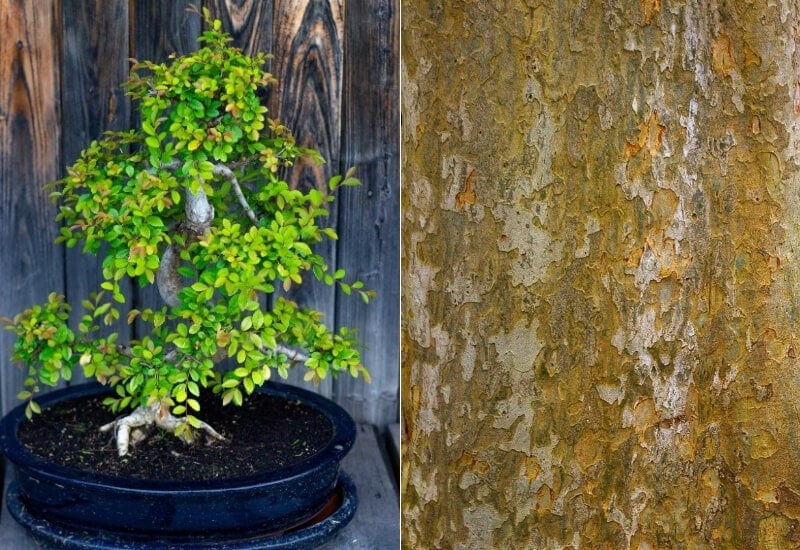
Chinese elm is known to have a great disease tolerance. As such, this cultivar builds on that strong resistance.
With an upright-spreading form, the variety ‘Emer II’ ALLEE resembles American elm in many ways. This is another example showing that finding an American elm replacement may be possible.
Whoever, like its parent, Chinese elm, this cultivar maintains some of its invasive tendencies. This is why many states continue to ban this plant.
Leaves
ALLEE Chinese elm has a dense canopy of dark green leaves. Each leaf has a lustrous appearance and fine serration.
Bark
Much like Chinese elm, the ALLEE variety has interesting exfoliating bark. This bark includes multiple colors including green, orange, and the typical light grey.
Fruit
This cultivar’s fruits are also similar to those of Chinese elm. They are rounded and have a distinct notch at the apex. Single seeds are located in the center of each samara.
12: Ulmus Americana ‘Princeton’ (Americanelm)
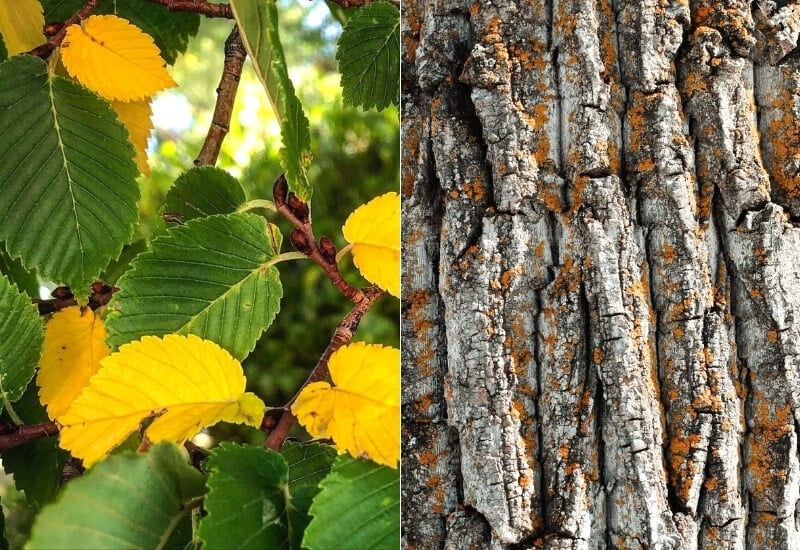
The ‘Princeton’ variety is a direct descendent of the American elm. It shares many similarities with its parent species including size and form.
Ironically, this cultivar was developed before the introduction of Dutch elm disease. So it appears that the good disease resistance of ‘Princeton’ is somewhat of a coincidence.
Still, this plant proves to resist the disease and other afflictions such as foliage feeder. As a result of this resistance, ‘Princeton’ is one of the most actively planted elm tree cultivars.
This tree can tolerate some light shade but prefers full sun. It is also adaptable to both wet and dry soils.
Leaves
As you might expect, the leaves of ‘Princeton’ are nearly identical to those of American elm. The difference is that the cultivated variety’s leaves are thicker.
Bark
The bark of ‘Princeton’ American elm is light grey and breaks into long flake-like plates as the tree expands. This leads to shallow vertical furrows along the trunk.
Fruit
This cultivar has light green samaras with an oval shape. Their edges are typically fringed with tiny white hairs. They grow in clusters are reddish-brown where they attach to the stem.
13: Ulmus Americana ‘Valley Forge’ (Americanelm)
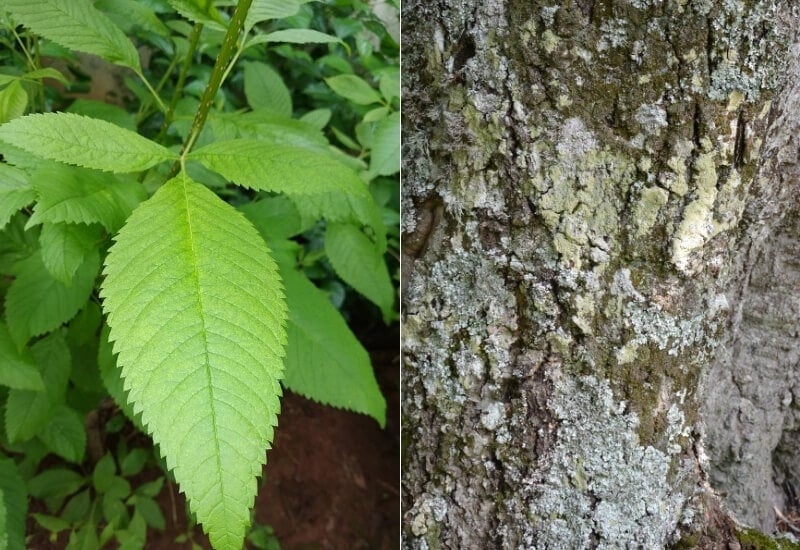
This is another direct cultivar of the American elm. Developed at the National Arboretum, ‘Valley Forge’ was one of the first cultivars to show a good resistance to Dutch elm disease.
This is a positive development, but ‘Valley Forge’ is not a perfect recreation of American elm. Its form tends to be looser and more open. Eventually, this form matures to become more reminiscent of its parent.
Thankfully, ‘Valley Forge’ is a fast-growing plant. So, it takes a bit less time to achieve the full vase-shaped form.
Leaves
The leaves of ‘Valley Forge’ are large and dark green. They feature the typical uneven base as well as a roughly serrated margin. Their fall color is an impressive yellow.
Bark
The bark of this cultivar has long angular fissures. These lie between long grey ridges that have a flat outer surface.
Fruit
‘Valley Forge’ has samaras that look like small green wafers. They are round and are typically sterile.
14: Ulmus ‘New Horizon’ (New Horizonelm)
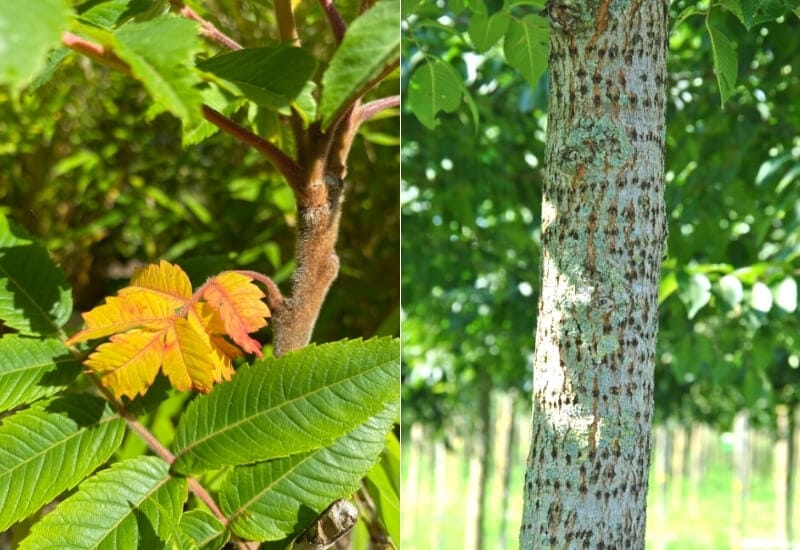
New horizon elm is a hybrid cross between Siberian elm and Japanese elm. This elm has a fast growth rate and typically reached 40 feet.
This canopy of this tree is less dense than other elms, but it still gives plenty of shade. The branches are upright and have a slightly arching habit.
This tree has a promising resistance to many common elm pests and diseases. It can also grow in many soil types including both acidic and alkaline.
Leaves
New horizon elm has dark green leaves with doubly serrated margins. They are about three inches long. The fall color is inconsistent but sometimes appears as a rusted red.
Bark
New horizon elm bark is light and smooth at youth. As the tree matures, the bark shows an increasing number of ridges and furrows. It also darkens its color.
Fruit
The samaras of new horizon elm are small and oval-shaped. Like other elms, they encase a single seed.
15: Ulmus Americana ‘Lewis & Clark’ PRAIRIE EXPEDITION (Prairie Expedition Elm)
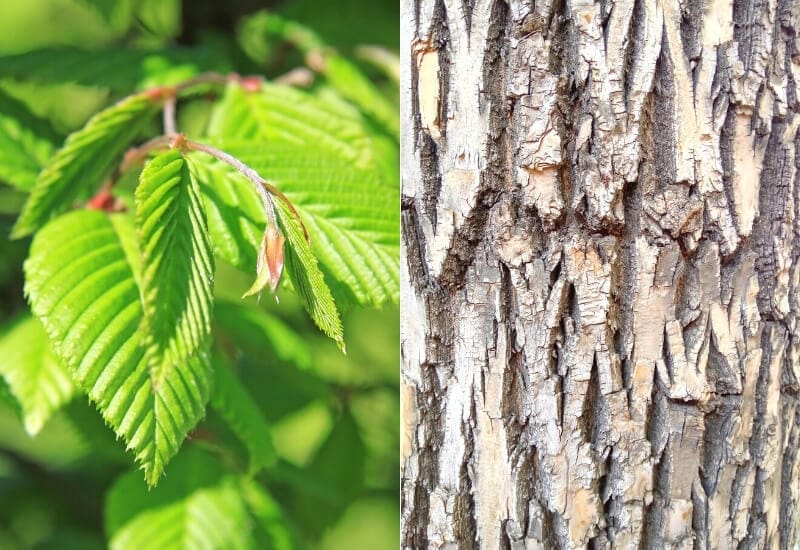
This cultivar became recognized in 2004. It bears the name ‘Lewis & Clark’ as its emergence occurred exactly 200 years after the famous expedition of those two explorers.
In nursery trade, the name prairie expedition is more common when referring to this plant. Because of its disease tolerance and adaptability to different soils, the popularity of prairie expedition elm has only grown since its inception.
Prairie expedition elm is a large shade tree. As a cultivar of the original American elm, it has a vase-like form. However, this tree tends to spread wider than many other elm varieties.
Leaves
Prairie expedition elm leaves are dark green in spring and summer. In fall they turn yellow. Look similar to American elm leaves and range in size from three to six inches.
Bark
This bark begins with a light brownish tan color. It then slowly changes to match the bark commonly found on its parent species.
Fruit
Prairie expedition elm has samaras that are small and circular. These are a contrast to the many elm samaras that have a more oval shape.
Conclusion
When attempting to identify elm trees use this article as a guide. Many elms are nearly identical. But differences in leaves, bark, and samaras often prove they are different species. By looking closely at these identification features, you can begin to pick out individual elms from the many cultivated and natural varieties.

Written By
John Haryasz
John Haryasz is a writer with a background in landscape architecture. His education includes a Bachelor of Science in landscape architecture from UMass, Amherst with a minor in psychology. Following graduation, John worked in a small landscape architecture office. In this role, he led many successful projects in Berkshire County, MA. After a few years, John began offering freelance design services. He has since produced designs for projects across the country. As a writer, John aims to share knowledge while promoting engagement with the outdoor world.
